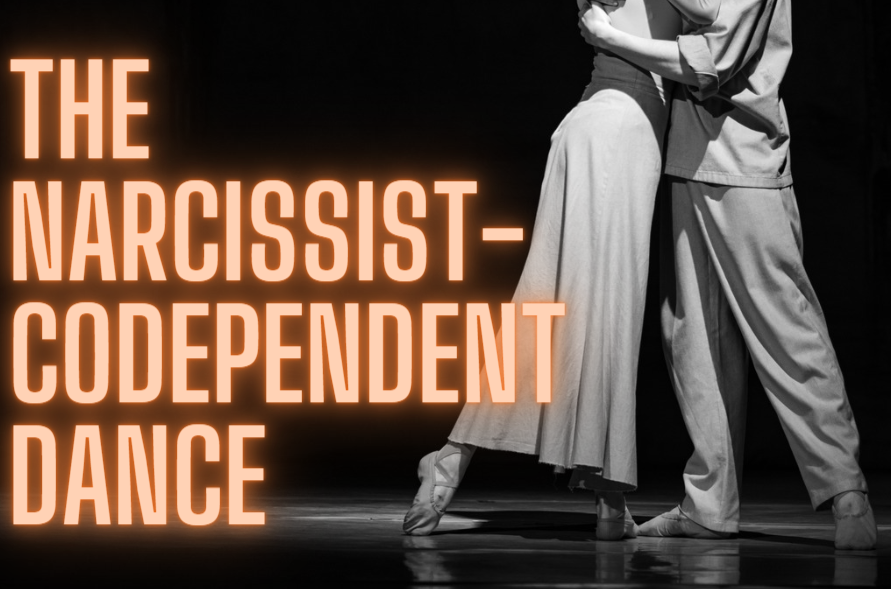
Introduction
In the realm of interpersonal relationships, a complex and somewhat unsettling dance often occurs—one between codependency and narcissism. This dance, often referred to as the ‘toxic tango’, is characterized by a harmful interplay of emotional and psychological manipulation that can pervade romantic relationships and turn them into a quagmire of control, emotional manipulation, and psychological harm. Understanding the dance, its steps, and its potential impacts, is key to recognizing it in real life and finding the way out.
Narcissism and codependency are not just simple traits or behaviors; they are deeply rooted patterns that significantly impact the individuals involved and their relationships. Often misunderstood and misrepresented, these terms demand clear comprehension and thoughtful reflection. This article aims to unravel the intricate dance between these two psychological constructs, with the goal of promoting healthier relationship dynamics.
Understanding Narcissism
Narcissism, by definition, is a personality disorder characterized by an inflated sense of self-importance, a deep need for excessive attention and admiration, and a lack of empathy for others. However, despite this seemingly clear-cut definition, understanding narcissism as a behavioral pattern is not a straightforward task. Narcissists often exhibit charm, charisma, and confidence, which can be attractive and misleading, especially in the early stages of a relationship.
One of the key traits of a narcissist is a sense of entitlement that drives their interaction with others. They often believe they are superior and that they deserve special treatment, which impacts their ability to engage in reciprocal relationships. This lack of reciprocity is particularly evident in romantic relationships, where they often prioritize their own needs and desires, showing little regard for their partner’s feelings or needs.
The effects of narcissistic behavior on romantic relationships are manifold. Over time, the narcissist’s constant need for admiration and disregard for their partner’s needs can create a significant power imbalance. This can lead to emotional manipulation, control, and even abuse, resulting in a highly toxic and damaging relationship environment.
This is where the dance begins. A narcissist’s behavior is not only harmful to them but also paves the way for the entrance of another destructive pattern – codependency. The stage is set for the dance to ensue.
Understanding Codependency
In the dance of relationships, the role of the codependent partner can be equally complex and potentially damaging. Codependency, a relational and behavioral condition, often manifests as an excessive emotional or psychological reliance on a partner. Those struggling with codependency may suppress their own needs and desires to focus on satisfying those of another person, which is often the narcissist in this toxic tango.
Like the narcissist, the codependent person also has certain typical traits that form the basis of their behavior. They often struggle with self-esteem issues, have a strong fear of being alone, and exhibit an overwhelming desire to please others. Additionally, they may have a tendency to prioritize the needs of others over their own and feel responsible for the actions and feelings of their partner.
Codependency’s effects on romantic relationships can be as damaging as those of narcissism, albeit in a different way. The codependent person often becomes an enabler, catering to the narcissist’s every need and desire, reinforcing the narcissist’s behavior and further encouraging the power imbalance inherent in such relationships.
The Dance between Codependency and Narcissism
Codependency and narcissism are not mere independent behaviors that happen to intersect occasionally. They are, in many ways, intertwined and mutually reinforcing, creating a potentially toxic and harmful dynamic in romantic relationships.
At first glance, narcissists and codependents may seem to be on opposite ends of the behavioral spectrum. Narcissists are typically characterized by an inflated self-image and an overpowering sense of entitlement, while codependents often struggle with low self-esteem and a compulsion to please others. However, it is these seemingly contradictory behaviors that form the basis for their mutual attraction.
The dance begins when the codependent person, driven by a need to be needed, meets the narcissist’s desire to be perpetually admired and catered to. The narcissist takes the lead, and the codependent follows. This cyclical pattern, if left unchecked, can lead to a downward spiral of emotional manipulation and psychological harm, turning the dance floor of their relationship into a battleground.
Consequences of a Codependent-Narcissistic Relationship
The dance between codependency and narcissism in romantic relationships doesn’t come without its consequences. As the rhythm accelerates and the pattern becomes more ingrained, the effects can range from emotional distress to psychological harm, impacting not only the individuals involved but also those around them.
To start with, the potential harm these relationships can cause to the individuals involved is significant. The narcissist, fueled by the constant admiration and attention, may delve deeper into their destructive patterns. Simultaneously, the codependent person might lose their sense of self, given their preoccupation with satisfying the narcissist’s needs and desires. As a result, the relationship becomes increasingly one-sided and toxic.
In the long run, such a relationship might lead to emotional exhaustion and even psychological trauma for the codependent person. They may experience feelings of worthlessness, anxiety, and depression. For the narcissist, the unchecked power and control might further solidify their narcissistic behaviors, making any form of empathy or mutual respect increasingly unlikely.
Beyond the personal realm, these relationships also carry societal implications. The perpetuation of such unhealthy dynamics can contribute to the normalization of emotional manipulation and control in relationships. This, in turn, can indirectly influence how younger generations perceive and engage in romantic relationships.
Recognizing a Codependency and Narcissist Relationship
Recognizing the signs of a codependent-narcissistic relationship is a crucial step in breaking free from the dance. Some of the common warning signs include a clear power imbalance in the relationship, one person constantly catering to the other’s needs and desires, and a lack of reciprocity in the relationship. In many cases, the codependent person may also display signs of emotional distress, while the narcissist may exhibit a lack of empathy.
Personal experiences and anecdotal evidence also offer invaluable insights into these dynamics. Stories of people who have navigated and eventually extricated themselves from such relationships can provide practical tips and warnings, helping others identify similar patterns in their own lives. These shared experiences, coupled with professional advice, can guide those caught in the toxic dance towards the exit.
Strategies for Breaking the Toxic Dance
While it may seem challenging, breaking free from the toxic tango of codependency and narcissism is entirely possible. The journey towards a healthier relationship pattern often involves introspection, professional help, boundary-setting, and self-care.
Therapy and professional help play a crucial role in this process. Therapists and counselors can provide the necessary tools and insights to help individuals understand and manage their codependent or narcissistic tendencies. They can guide individuals towards a path of self-discovery and recovery, helping them recognize their worth and the need for healthy, reciprocal relationships.
One important step towards breaking the cycle is setting boundaries. In a codependent-narcissistic relationship, boundaries are often blurred or non-existent, contributing to the power imbalance. Creating and enforcing boundaries can provide the space for the codependent person to rediscover their individuality and the narcissist to recognize the need for mutual respect.
Self-care and healing are other crucial components in this journey. In the pursuit of pleasing the narcissist, the codependent person often neglects their own needs. Thus, focusing on self-care can be a step towards regaining one’s self-worth and independence. Activities such as meditation, exercise, spending time in nature, or engaging in hobbies can contribute significantly to the healing process.
Recovery and Building Healthier Relationships
After breaking free from the dance, the road to recovery can seem daunting, but it’s also full of potential for growth and learning. A vital part of this process is understanding one’s own needs and setting realistic expectations for future relationships.
Developing healthier relationship habits is a key aspect of recovery. This involves learning to communicate effectively, understanding and respecting personal and partner’s boundaries, and fostering mutual respect and empathy in relationships. Moreover, learning to be comfortable with one’s own company can help alleviate the fear of being alone often experienced by codependent individuals.
For those who have managed to step away from a toxic relationship, it’s essential to remember that it’s a significant accomplishment. The healing process might take time, and there might be setbacks, but every step taken towards healthier relationships is a step in the right direction.
In this complex and often challenging dance of relationships, understanding the dynamics and knowing when to step back is crucial. Through awareness, professional help, and self-care, the dance can be untangled, and healthier patterns can emerge.
Conclusion
This exploration of the intricate dance between codependency and narcissism in romantic relationships sheds light on a complex and challenging dynamic. It reveals how these two behavioral patterns, though seemingly contrasting, can entangle individuals in a toxic, destructive dance. However, as daunting as the dance may be, it is not inescapable.
Understanding the dynamics of narcissism and codependency, recognizing the signs, and implementing strategies to break free are crucial steps towards healthier, more balanced relationships. While the journey can be challenging and often requires professional help, the potential for personal growth and healthier relationships makes it a journey worth undertaking.
In conclusion, the dance between codependency and narcissism in romantic relationships, also known as the toxic tango, is an important topic in the realm of interpersonal relationships. It is a subject that warrants further exploration and discussion, not just for the wellbeing of individuals involved in such relationships, but for the broader societal implications it carries.
References & Further Reading
For readers interested in delving deeper into the subject, a wealth of resources is available. These range from academic studies on narcissism and codependency, books by renowned relationship psychologists, and anecdotal accounts of individuals who have successfully navigated their way out of such relationships. The journey to understanding and healing may be long, but it is a journey well-accompanied by those who have studied, lived, and shared their insights into this complex dance. The list of resources provided here is just a starting point for further exploration.




